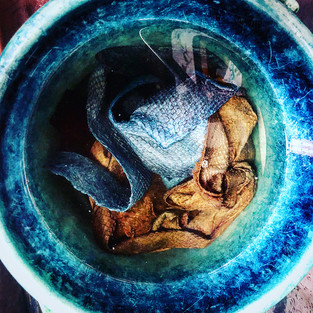Location: Viljandi, Estonia
Participants:
University of Arts London - Elisa Palomino
In collaboration with traditional tanning specialist Lotta Rahme, Elisa presented on Studying Traditional Crafts: Goals and Methods in Higher Education.
The delivery was a material-based exploration looking at the role of fish skin in sustainable design practice, developing models of socially responsive design innovation and knowledge transfer. The research looked at the geographical use of fish skin material in circumpolar cultures. The aim is to explore how fish skin artisanship through participatory design practices can explore fashion for social cohesion through the partnership of tradition with contemporary design from higher education students. There is also a desire for reviving technologies of the past as well as for securing the transfer of indigenous knowledge systems related to fish skin processing.
The presentation described the workshops developing methods of tanning fish skin and producing fish skin material samples in areas where traditionally fish skin was developed, where experienced fish skin craftspeople have passed down the endangered Arctic fish skin craft to the next generation of students from universities in the circumpolar area (Iceland, Denmark, Sweden, Finland, Hokkaido, Japan, northeast China and Alaska) as part of the sustainable fashion higher education program. The methods of sustainable material engagement and the full immersive experience through a teaching-in-the field approach are recommended as transferable skills for educational models. The workshops demonstrate how relevant the Indigenous fish skin knowledge - in partnership with sustainable design strategies - can connect people to their culture, communities and the environment.
Location: Hokkaido, Japan
The use of fish skin for the construction of garments is an ancient tradition shared by Arctic coastal societies, some of the earliest traces being found from the Ainu populations in Hokkaido, Japan.
The FISHSkin project has developed common interests in the UK and Japan around topics of fish skin, leather and sustainability. The project has brought together a community of experts including fashion design academics and practitioners, and artisan experts in natural dyes, with the aim of improving knowledge of sustainable methods for fish skin production as a greener alternative to exotic leather. The FISHSkin project has mapped existing traditional knowledge on natural dying from Japanese craftsmen in order to transfer the skills into fish skin.
During the trip Elisa Palomino worked with a traditional Japanese dyer at Tokushima and tested indigo dyeing on fish skin. The results were later tested on at Ars Tinctoria laboratory by Gustavo Defeo and Massimo Mancuso to evaluate the possible use in contemporary industrial dyeing for fish skin. The physical and rheological properties of the indigo and persimmon natural dye were measured for the evaluation of dye stability. The tests were found to be suitable. The samples were subjected to light and rub fastness tests and colour measurements. Colour consistency and fastness results, especially after fixation, are comparable with those on conventional leather. Fastness properties were analysed following updated ISO standards.
Location: Eilat, Israel
The FISHSkin project has been launched in February 2019 with the first consortium meeting taking place in Eilat, Israel. The interdisciplinary project team was hosted by Dr. Hanna Rosenfeld and the team of Israel Oceanographic and Limnological Research Institute (IOLR), one of our partner organizations.
It's been wonderful and exciting to meet each other for the first time, together explore the intricacies of the fish reproduction in captivity, and do a fair share of planning on the next steps as a research collective - all in the spectacular backdrop of Eilat's nature.
























